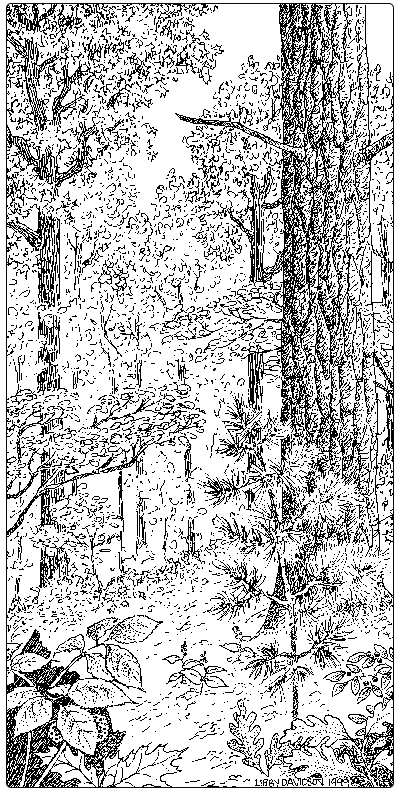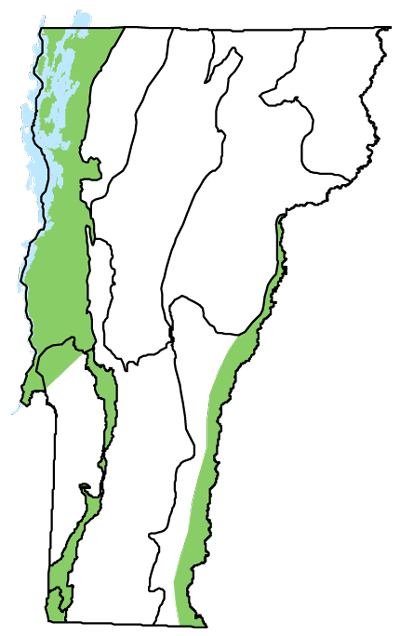Ecology and Physical Setting
Southern New England is the real home of this community. Oaks and pines are the dominant vegetation in much of eastern Massachusetts and southern New Hampshire, where glacial outwash prevails, and where historical land use has had a significant impact on forests.
In Vermont, we find similar conditions in the Champlain Valley, the Southern Vermont Piedmont (especially the Connecticut River Valley), and portions of the Taconic Mountains and Vermont Valley. Coarse glacial and post-glacial surficial deposits are common in these regions. While these deposits can be of various origins (including deltas, valley-side terraces, and eskers), they all create a similar setting: a flat or nearly flat terrace, often incised by streams creating steep slopes, with coarse, well-drained soils. Red oak, black oak, and white pine can compete well on these sandy terraces and slopes.
Mesic Pine-Oak Sandplain Forest is closely related to Dry Pine-Oak-Heath Sandplain Forest. They occur on similar soils and landscape settings, but the primary distinctions are the frequency of fire and the difference in soil moisture. Mesic Pine-Oak Sandplain Forests occur in settings that historically may have been less prone to lightning-caused fires than Dry Pine-Oak-Heath Sandplain Forests. These settings include small, sheltered terraces and the incised slopes of larger deltaic flats. In addition, at some sites, the soils likely hold enough moisture to limit the spread of any fires that do start. When present, these relatively moist soils support more mesic-site species.
Vegetation
We have no known undisturbed examples of this forest type, so it is difficult to fully understand its natural vegetation. Historical information, together with our studies of some of the younger examples, suggests that mature Mesic Pine-Oak Sandplain Forests will have white pine, red oak, and black oak as canopy dominants. Black oak is absent in many of the younger examples. Pitch pine is usually not found in these forests. Red maple, beech, and hemlock are abundant in some examples, and the latter two species may eventually become dominant on these sites in the absence of disturbance. The shrub layer is a mixture of tall shrubs like witch hazel and smooth shadbush, and low shrubs including blueberries and maple-leaved viburnum. Herbs are generally sparse; they include wintergreen, pipsissewa, and bracken fern.
Occasional wet sites occur within this community when thin clay layers are found in the otherwise well-drained coarse soils. These clay layers impede water and transport it laterally. Where this water emerges as seepage on slopes at the edge of a terrace, the growing conditions can be enriched. These places can support species like sensitive fern, scouring rush, white ash, and basswood.
Wildlife Habitat

early June.
Mesic Pine-Oak-Heath Sandplain Forests provide an unusual and important combination of wildlife habitats. They are sandy and dominated by oaks, but often occur near large rivers. Acorns are a primary food for wood ducks, which may both feed in these forests and nest in mature tree cavities that are near water. Fowler’s toad is a very rare species in Vermont, known only from near the Connecticut River and its tributaries. It requires deep sandy soils for burrowing and, to our south, is frequently found in oak-pine forests near ponds or permanent water. Mesic Pine-Oak-Heath Sandplain Forest provides these habitat conditions and at least one of Vermont’s historic populations occurred in this community type.
Red oak and black oak also provide an important source of acorns used by a wide variety of birds, mammals, and insects, including grey squirrel, eastern chipmunk, white-tailed deer, and black bear. Pine warblers, eastern wood pewees, and scarlet tanagers all nest in this community. Acorn weevil is a native beetle that relies on acorns for food and reproduction.
Successional Trends
Most Mesic Pine-Oak Sandplain Forests have been cleared in the past. White pine is usually the first tree species to recolonize these sites, followed later by red oak. At sites with black oak, it seems to be slowest to establish in the canopy. All three of these species can tolerate summer droughts and occasional fires.
In Mesic Pine-Oak Sandplain Forests, natural disturbances such as fire and windstorms can change the species composition temporarily. In addition to white pine, other early-successional species include black birch, black cherry, and bigtooth aspen. Fires that remove the duff layer and create canopy openings can result in a transition to a Dry Pine-Oak-Heath Sandplain Forest characterized by pitch pine and heath shrubs.
Related Communities
- Dry Pine-Oak-Heath Sandplain Forest is very closely related to Mesic Pine-Oak Sandplain Forest. Both occur on coarse, well-drained soils. In the Champlain Valley, the two communities are often juxtaposed and interfingered. The main differences are soil moisture and fire regime. Dry Pine-Oak Heath Sandplain Forests have drier soils and are more prone to frequent fires.
- Dry Red Oak-White Pine Forest can have similar canopy species but is found on till or shallow-to-bedrock soils as opposed to coarse, well-drained soils. Black oak is absent.
Conservation Status and Management Considerations
This is a rare community in Vermont, and we know of no mature examples. Several of the known examples are on conserved lands. Additional examples should be sought out for conservation. At several sites the persistence of this community is threatened by non-native, invasive species. Deer browse is a threat to oak regeneration. Any timber management should consider natural ecological processes and should encourage regeneration of the species that would naturally grow on these sites.
Distribution/Abundance
Mesic Pine-Oak Sandplain Forest is a rare community in Vermont, found only in the warmest climate areas on coarse, well-drained soils. Similar communities are common in southern New England.
Characteristic Plants
Trees
Abundant Species
White pine – Pinus strobus
Red oak – Quercus rubra
Occasional to Locally Abundant Species
Black oak – Quercus velutina
Eastern hemlock – Tsuga canadensis
American beech – Fagus grandifolia
Red maple – Acer rubrum
Black birch – Betula lenta
Shrubs
Abundant Species
Witch hazel – Hamamelis virginiana
Maple-leaved viburnum – Viburnum acerifolium
Occasional to Locally Abundant Species
Beaked hazelnut – Corylus cornuta
Smooth shadbush – Amelanchier laevis
Sweet fern – Comptonia peregrina
Striped maple – Acer pensylvanicum
Black huckleberry – Gaylussacia baccata
Herbs
Abundant Species
Bracken fern – Pteridium aquilinum
Wintergreen – Gaultheria procumbens
Pipsissewa – Chimaphila umbellata
Occasional to Locally Abundant Species
Starflower – Lysimachia borealis
Sarsaparilla – Aralia nudicaulis
Poverty grass – Danthonia spicata
Intermediate wood fern – Dryopteris intermedia
Invasive Non-native Plants
Norway maple – Acer platanoides
Morrow’s honeysuckle – Lonicera morrowii
Glossy buckthorn – Frangula alnus
Common buckthorn – Rhamnus cathartica
Rare and Uncommon Plants
Scarlet oak – Quercus coccinea
Smooth false-foxglove – Aureolaria flava
Spotted wintergreen – Chimaphila maculata
Hay sedge – Carex siccata
Blunt-lobed grapefern – Botrychium oneidense
Associated Animals
Eastern gray squirrel – Sciurus carolinensis
Southern flying squirrel – Glaucomys volans
Eastern wood pewee – Contopus virens
Scarlet tanager – Piranga olivacea
Pine warbler – Dendroica pinus
Wood duck – Aix sponsa
Rare and Uncommon Animals
Fowler’s toad – Anaxyrus fowleri
Places to Visit
Sunny Hollow Natural Area, Colchester, Town of Colchester
Wilgus State Park, Weathersfield, Vermont Department of Forests, Parks, and Recreation
Bellows Falls Union High School Forest, Westminster
Black Mountain Preserve, Dummerston, The Nature Conservancy
